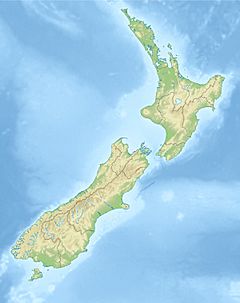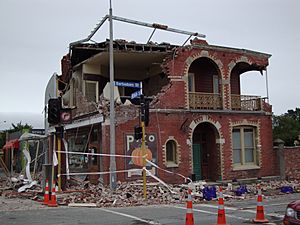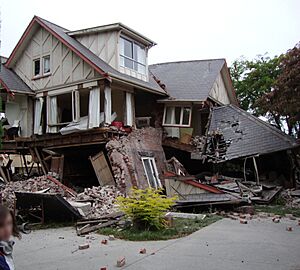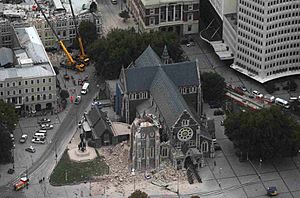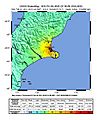2011 Christchurch earthquake facts for kids
 |
|
| UTC time | 2011-02-21 23:51:42 |
|---|---|
| ISC event | 16168897 |
| USGS-ANSS | ComCat |
| Local date | 22 February 2011 |
| Local time | 12:51 p.m. NZDT |
| Magnitude | 6.2Mw (GCMT) |
| Depth | 5 km (3.1 mi) |
| Epicenter | 43°35′00″S 172°42′04″E / 43.5834°S 172.7012°E near Lyttelton, Canterbury, New Zealand |
| Areas affected | New Zealand |
| Max. intensity | IX (Violent) |
| Peak acceleration | 1.88g (city); 2.2g (epicentre) |
| Tsunami | 3.5 m (11 ft) tsunami waves in the Tasman Lake, following quake-triggered glacier calving from Tasman Glacier |
| Landslides | Sumner and Redcliffs |
| Casualties | 185 deaths 1,500–2,000 injuries, 164 serious |
The 2011 Christchurch earthquake was a strong earthquake that hit the South Island of New Zealand. It happened at 12:51 p.m. on 22 February 2011. The earthquake had a magnitude of 6.3.
It struck about 5 kilometers (3 miles) underground. This made it very damaging because it was close to the surface. The quake hit the Canterbury area and caused a lot of damage. Many people were hurt and died in Christchurch, New Zealand's second-largest city.
This earthquake was the biggest aftershock of the 2010 Canterbury earthquake from September 4, 2010. Even though it was an aftershock, people see it as a separate event. It was smaller than the September earthquake. However, it caused more damage. This is because it was closer to Christchurch and closer to the surface. Also, it happened at lunchtime on a Tuesday. More people were out and about, making them more likely to be hurt by falling buildings. Many buildings were also already weak from the earlier quakes.
New Zealand's Prime Minister, John Key, said that February 22 "may well be New Zealand's darkest day." Sadly, 185 people died in the earthquake. Between 1,500 and 2,000 people were injured.
After the first day, 65 people were known to have died. Over 100 people were thought to be trapped in one building. The New Zealand Fire Service worked hard to rescue people. Many were injured and stuck in buildings. Most of the city lost electricity. Water and sewer services also stopped working in many areas. People were asked to save water and collect rainwater. The highest level of emergency was declared. Army medical staff helped treat the injured.
Contents
Buildings Damaged in Christchurch
Many buildings collapsed in downtown Christchurch. This included areas around Cathedral Square. The spire of ChristChurch Cathedral completely fell down. Christchurch Hospital had to be emptied because of damage. But it soon reopened to help the injured. They treated over 220 serious injuries. Sometimes, they even worked by flashlight.
The New Zealand defence forces helped move people out of the city center. Fires were reported at the Canterbury Television (CTV) building. The Pyne Gould Corporation building was also badly damaged. Some of its 200 workers were believed to be trapped inside. People heard screams from within the building. The old Canterbury Provincial Chambers building also suffered major damage.
The Statistics New Zealand buildings in Christchurch were damaged. These buildings were supposed to process the March 2011 census for New Zealand. The census was canceled because people's lives in Christchurch were so disrupted. This was only the third time the census had been canceled in New Zealand's history.
ChristChurch Cathedral Damage
ChristChurch Cathedral lost the top of its main spire. Its roof also fell in. At first, reports said 22 people were in the spire when it collapsed. However, after the building was made safe and searched, no bodies were found there.
Cathedral of the Blessed Sacrament Damage
The Catholic cathedral in Christchurch, the Cathedral of the Blessed Sacrament, was also badly damaged. About half of it collapsed.
Damage in Lyttelton
Buildings in Lyttelton were also damaged. A fire officer said that 60% of the buildings on the main street collapsed. The town's historic Timeball Station was also seriously damaged. The New Zealand Historic Places Trust owns the building. They decided it was too unsafe to repair. It will be taken apart, if possible, and maybe rebuilt later.
Impact Beyond Christchurch
About 30 million tonnes of ice broke off the Tasman Glacier. This happened about 200 kilometers (124 miles) from the earthquake's center. The ice fell into Tasman Lake, creating waves 3.5 meters (11.5 feet) high. These waves hit tour boats.
The earthquake was felt far away. People felt it as far north as Tauranga and as far south as Invercargill. In Invercargill, the 111 emergency network was damaged and stopped working for a time.
Related Earthquakes
Images for kids
-
Oxford Terrace Baptist Church was one of many churches damaged by the quake
-
The effect of liquefaction in North New Brighton, Christchurch
-
Handover of the final report of the Canterbury Earthquakes Royal Commission, at Government House, Wellington, on 29 November 2012. Left to right: Sir Ron Carter; Colin McDonald (secretary and chief executive of the Department of Internal Affairs); the governor-general, Sir Jerry Mateparae; Mark Cooper; Richard Fenwick; and Justine Gilliland (executive director of the Royal Commission).
See also
 In Spanish: Terremoto de Christchurch de febrero de 2011 para niños
In Spanish: Terremoto de Christchurch de febrero de 2011 para niños


